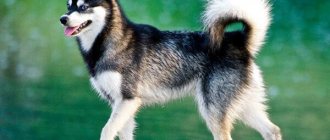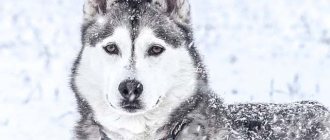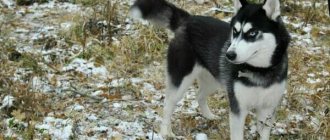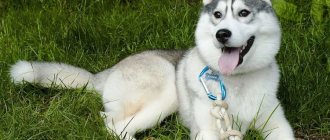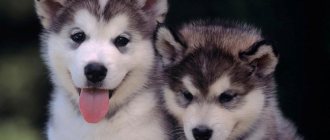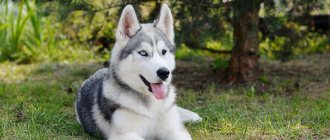The Siberian Husky is a medium-sized working dog.
These dogs originated in the north and were used there to move goods. Their compact body is framed by fluffy fur, and their face with blue eyes is striking in its cuteness. In this article we will look at the Siberian Husky breed standard. Today, huskies still perfectly perform their main function - they know how to be in a harness, carrying light loads. They are capable of being in harness for quite a long time, as they are quite hardy.
Details about the breed
Husky character description
By nature, Huskies are very kind and friendly towards everyone. In addition, they are attentive and sensitive. By nature, Huskies are leaders and always try to dominate. Huskies treat strangers absolutely calmly; they also do not show aggression towards other dogs. As they get older, huskies become more restrained in expressing their feelings.
Thanks to its good intelligence, flexibility and activity, dogs of this breed become good and faithful companions for their owner.
Husky parameters
Males are larger than females. The body weight of males ranges from 20.5 to 28 kg, while females have a body weight of 15.5 to 23 kg. The height for males is from 53.5 to 60 cm, and females have a height from 50.5 to 56 cm. Deviations from these parameters are not considered the norm.
Head
The main feature of huskies is their eyes. Their color can be blue or brown. The eyes themselves should not be too close apart. Eyes that are too close or too far away will be considered a fault.
ATTENTION! It is better to look at the face of husky dogs in pictures to understand how cute and beautiful they are.
The Husky's thick and fluffy ears are medium in size and triangular in shape with slightly rounded tips. They are located high on the head.
Neck and chest
The neck of Siberian Huskies is of medium length and can bend within the required limits. If the neck is too long, short or massive, this is a disadvantage.
The chest of Siberian Huskies is powerful and deep. The disadvantages of the breed are an overly wide or barrel-shaped chest.
Paws
The paws of Siberian Husky dogs should be straight when walking or running. The front and hind legs are spaced quite widely, always parallel. Elbows should be close to the body. The thighs must be powerful.
Toes located inside the paw are a deviation from the standard.
The toe pads are designed for walking on snow, so there is no need to clear them of snow. But when moving quickly on the crust, dogs’ paws can get minor injuries. Therefore, some people put special boots on their dogs to protect their paws from injury.
Tail
The Siberian Husky dog breed has a very fluffy tail, just like them. When the dog is in an excited state, it rises above the back and looks very beautiful, similar to a fox's tail. The tail should not curl to the side; when at rest it is simply straight.
Coat
According to the standard, the color of a given dog breed can be completely different. Can be either black or white with various color combinations. The most common coat colors of dogs of this breed are black and gray in combination with white. A little less common are brown-white and fawn huskies. It is very rare to find pure black, brown and white huskies.
coat characteristics
The husky's coat is quite thick and short. The dog actively sheds and requires careful regular grooming. In addition, the Husky's coat needs to be washed periodically to keep it looking well-groomed. To wash, you need to use special products for a specific type of coat. After washing, the dog's hair must be thoroughly dried and combed. Dogs are allowed to undergo trimming to give them a more neat appearance, but only on the sides and between the toes.
IMPORTANT! Trimming in other places is not allowed, otherwise the dog may be removed from the competition.
Smell
Their fur has a self-cleaning function, so they have almost no odor. The only time a slight odor may be present is when the wool gets a little wet.
History of the Husky breed
Carefully! You can fall in love with a Siberian Husky dog at first sight! And all because we are people born and raised in cities among asphalt and concrete, while huskies are a child of wild nature, its personification. The breed was bred among the endless snow and the northern peoples used it as a sled dog. The homeland of the husky is northern Russia, Siberia. Huskies are also very good-natured. This is not a protector or a guard. If you want a dog with a meaner personality, choose a German Shepherd or a Doberman Pinscher.
Husky portrait
Moreover, this dog lived in the house with its owners. She was put to bed with the children so that she could warm the children with the warmth of her body. Of course, the husky was treated like a member of the family.
The Far North began to be actively developed starting around the 17th century. It was then that this dog caught the eye of the discoverers. I liked dog riding and began to develop. In addition, the “gold rush” began in America and the Americans gladly exported Siberian huskies to their country through the Far East.
The North is a natural environment for huskies
The dog has proven itself to be excellent both to gold miners and representatives of the Russian Empire with its qualities. Strong and courageous, sociable, strong, intelligent, undemanding to keeping in cold conditions - these are the main advantages of the breed. In Alaska, thanks to the speed of the sleds, a city was even saved from an epidemic. And during the Second World War, they had no equal in the positions of rescuers.
The facial expression of a husky can range from kind and sweet to stupid and menacing.
The Siberian Husky, as an official breed, appeared in 1934 thanks to American dog handlers, who “legalized” this miracle of Siberia.
Video: husky in harness
“We will go, we will rush!”: sled huskies in the village of Frolovka give rides to children and adults (VIDEO)
At a speed of about 30 km/h, a sled drawn by eight huskies is flying through a snowy forest. For the third winter, anyone can become a passenger on the “tail flight” - hundreds of people from all over the region come to the small village of Frolovka in the Partizansky district on weekdays and weekends. VL.ru correspondents also visited the Panishev family, lovers of sled dogs.
Oleg and Elena Panishev first dog 11 years ago. Now Norta is the oldest, smartest and cunning. For example, he may pretend to be deaf “due to old age” so as not to carry out a command. Although when she needs it, she can even hear the candy wrapper of an unwrapped chocolate bar. She is also the most seasoned female in the pack. Now there are about 30 Siberian Huskies in the pack, and all the girls are Northa’s children. Oleg prefers not to name the exact number of his pets - it is a bad sign to count living creatures by their heads. Moreover, the dogs, as the owners explain, are “workers.” They are bred and trained specifically for sports.
Then the Panishevs, then still residents of Vladivostok, kept their daughter Northa. We tried riding on a double and liked it. This is where my passion for sledding began. They began to breed huskies and organized the Primorsky Sled Sports Center in Vladivostok (PrimCES - an organization under whose auspices many competitions are now held). When there were seven dogs in the family, we decided that we had to move. We bought a house in Frolovka. They have been living in the village for four years now. We acquired livestock—horses, poultry, goats. The Nubian goat Byasha, by the way, is also trained - he jumps over obstacles, dances, and gives his hoof. But the noisiest and most cheerful four-legged animals are, of course, huskies.
The average daily distance for dogs is 20 km, so you have to train a lot with them. Sleigh rides for guests are, to some extent, also part of the activity. The maximum speed that these dogs developed in a sled team was 32 km/h. But this is, let’s say, in a rush. They usually run slower. The speed is affected by air temperature, condition, snow packing and many other factors. Huskies can also be harnessed to a bicycle (although this requires very controllable animals) and an ATV - then they go faster, 39-40 km/h.
VIDEO:
In fact, you can harness not only sledding animals - husky, malamute or samoyed - into a harness. Any dog - if, of course, you work with it correctly - likes to run. There are sledable Labradors, and even dachshunds - for short distances. “In the pack, of course, there is a hierarchy - we still have a matriarchy, but the male is already growing up and is making attempts to become the boss,” says Elena Panisheva. “They are very kind to people.” In principle, they are quite loyal to other dogs - occasionally there are clashes. Huskies are very active, and you should definitely play sports with them. Some people go to the mountains with their pets, others just travel.
The most difficult thing with these dogs is not washing or feeding, but training. There are instructors, there is the Primorsky Sled Sports Center. Every year there is a cynological camp “Mordog”, where people from different cities of the Far East come with their pets. Any trained dog knows a minimum set of commands: “Come to me!”, “Near!”, “Sit”, “Forward”.
You have to work with your pet. It happens that a person gets a dog just because of a beautiful picture and blue eyes. But he doesn’t want to run with her. As a result, the dog “eats” the apartment because it lacks activity. And people come to our fence and ask: take the dog. Of course we don't take it. We have an already formed flock, and introducing someone new into it is very difficult. And besides, our dogs are “working”, and an ordinary husky will lag behind them in speed.”
You can come to Frolovka to visit the Panishevs with a tour group, or you can do it yourself. Everything is already busy on weekends, but there are also guests on weekdays - children and adults, professional skiers and even grandmothers. Everyone chooses their own individual route. True, the sleds for guests are not sports sleds with a canopy, but, as Oleg Panishev calls them, “non-killer sleds.”
Homemade wooden sleds with a pattern, at first glance, seem “flimsy” - in fact, this is not the case. The parts are connected by movable mechanisms that can withstand loads that would cause the welded structure to break. The sled has been serving faithfully since 2009 - only the plastic on the skis changes (they are made of ordinary sheet polyethylene and are washed relatively often).
You can ride on the “sled” sitting down - this is how kids usually ride, or you can stand on the runners - the main thing is to hold on tightly, brake or turn in time (tilting the structure to the right or left). And follow safety precautions. The dogs, explains Oleg Panishev, are harnessed using a pull, over which you cannot step - if the person standing on the brake relaxes, the huskies can run forward and the sled will knock you off your feet. And when you’re on the brake, you can’t let go of your hands—the dogs will pull you and you’ll fall.
In general, the sleigh cannot be released until the next person arrives. In any case, the main direction is set by the dogs - where they run, the team will go there. At the same time, animals understand the commands “Right” and “Left”. And after riding, they gladly allow themselves to be petted.
There are not many long, relatively calm and at the same time good paths in the taiga where dogs could run in the region. At 20-50 km you can cross along old military roads. We ran about 40 km from Razdolnoye to Tavrichanka along the river, through the Amur Bay (Second River - Cape Peschany - Second River). But a longer route, says Elena, is still in development. “Denis Drekov helps us with the route - he knows the roads of the region very well, because he is interested in serious hiking,” says the husky’s owner. — We would like to organize a trek of 100-200 km with the dogs of our Primorsky Sled Sports Center. Each dog will have an individual route developed.”
But sports competitions are held regularly - for example, on February 22, on the territory of a forest nursery in the village of Kamenushka, Ussuri Okrug, the third stage of the Snow Dog Stars sledding competition was held on Monday (Read more...).
You can come visit the Panishev family and their furry pets by calling in advance and making an appointment. 8-924-230-83-90 - Elena. also buy a tour and get in an organized group to Frolovka using the VL.ru Poster.
An Antarctic Tale (1983)
From the Japanese Arctic station, three researchers were sent to the mainland highland: a meteorologist, an experienced mountaineer and a professor of geophysics to accurately measure the height of the elevation and location. They set off on a team of 15 dogs. Unforeseen difficulties arose during the trip, weather conditions deteriorated and they returned much earlier than planned. Due to weather conditions, the entire team was evacuated; they decided to return for the dogs later; the animals were left with a week's supply of food. But a series of circumstances prevented them from returning. One of the researchers does not give up trying to return for loyal friends.
Snow Dogs (2002)
Ted Brooks is an excellent dentist, has a successful career, and is a worthy son of his father, also a former dentist. Suddenly, his measured life is disrupted by the news that a certain Lucy has died in Alaska, who bequeathed to him all her property, including 8 dogs, but that’s not all, the woman claims that he is her son. After talking with his parents, he finds out that he was indeed adopted. Ted decides to go to his mother's homeland and find out how she lived. Alaska presents many surprises: piercing winds, bitter cold and dogs instead of transport.
Snowy Five (2008)
Little Adam has dreamed of participating in dog sled races since he was little, but the kid only has one dog named Shasta. On Christmas Eve, he makes a wish to have several puppies. By an absurd accident, five golden retrievers end up on a plane flying to snowy Alaska. Stepping off the plane in a strange and cold place, the puppies meet Shasta, who comes up with an idea: these retrievers are no worse than sled dogs, and they can help make his owner's dream come true.
How to choose a partner for a dog
If all the pros and cons are weighed with a preponderance in favor of breeding, you can think about the issue of selecting a partner. First of all, I want to draw your attention to the fact that maintaining the temperament of a Siberian Husky is no less important than maintaining external characteristics. Unfortunately, when breeding, people often forget about the importance of a dog's character. It should be such that the person next to you feels comfortable. In other words, no aggression! The Siberian dog, by the way, is not predisposed to it, but anything can happen.
And, of course, for breeding it is extremely important that the selected dog is healthy. Not a single one, even the cutest Siberian dog, is suitable for breeding if it has any hereditary disease. Even if the breeder has sincerely become attached to such a husky. Only a healthy individual with exceptionally good performance data is suitable.
I also recommend paying attention to what a Siberian dog looks like. At the same time, I do not mean eye color or coat shade - the most interesting thing is that the standard does not provide for restrictions on what attracts most about these four-legged animals. But it’s worth taking a closer look at the body structure and movements.
I think it makes sense to listen to experts who distinguish the following types of breeding in the case of huskies:
- Linebreeding - it is appropriate to use it if you want to consolidate any characteristics. In this case, breeding may consist of inbreeding. However, with a common ancestor no earlier than the third or fourth generation.
- Outcross - in this case, the puppy is obtained from individuals who are not relatives at all. A similar approach is necessary if breeding is aimed at eliminating hereditary diseases.
